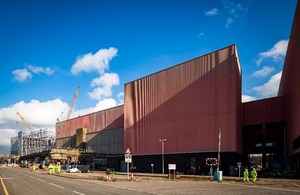
Sellafield’s Ion Exchange Effluent Plant
Thanks to the Site Ion Exchange Plant at Sellafield, we can remove the majority of radioactive isotopes from water used in our nuclear operations, ensuring that any water we discharge into the sea is safe and well within permitted discharge limits.
What is the Site Ion Exchange Plant (SIXEP)?
SIXEP filters and removes radioactive isotopes – such as Caesium and Strontium – from water that’s been used in nuclear operations across the Sellafield site so that those isotopes aren’t discharged into the sea.
It is because of this work that people working at Sellafield affectionately refer to the plant as the kidneys of the site.
SIXEP also keeps the pond in our Fuel Handling Plant cool, provides storage for sludge and spent ion exchange material, and processes sludge-rich, active liquors generated from hazard reduction activities in legacy facilities.
The Fuel Handling Plant pond
How does SIXEP work?
We use water in many of our nuclear operations at Sellafield. For example, we use it to cool used nuclear fuel held in storage ponds, and we also utilise it for domestic purposes, such as heating and providing hot water within site facilities.
Because it has been in contact with radioactive materials, it is inevitable that the water will contain radioactive isotopes and so it sent via an extensive system of pipes across the site to SIXEP.
Inside SIXEP
Once inside the plant, the water goes through 2 processes:
-
Sand Bed Filters: the water is collected in a tank, then pumped through large containers filled with sand. The sand acts as a filter, removing tiny particles. We capture and store these particles on the site.
-
Ion Exchange Beds: After sand filtration, the water passes through containers filled with Clinoptilolite, a natural mineral from the Mojave Desert in California. These ion exchange beds are highly effective, removing over 99.9% of the remaining radioactive caesium and strontium from the water.
The impact of SIXEP
SIXEP had an immediate impact on our environmental performance, massively reducing our radioactive discharges as soon as it started operations in 1985.
Since then, SIXEP has processed more than 30 million cubic metres of water – enough to supply every household in the UK with water for around 3 days, or over 85 million household-days of use.
The construction of SIXEP
Our challenge
- aging infrastructure: as a facility that has been operational since 1985, maintaining and upgrading aging infrastructure is a continuous challenge.
- storage limitations: managing the storage of spent clinoptilolite waste and other by-products is an ongoing issue.
- operational efficiency: ensuring the plant operates efficiently while meeting stringent environmental and safety standards requires constant attention and adaptation.
Protecting the environment in the future – extending SIXEP
To ensure we can continue to minimise our impact on the environment, we are extending SIXEP.
The project – known as the SIXEP Continuity Plant (SCP) will integrate seamlessly with the existing plant, ensuring continued operations for decades to come by providing new sand bed filter and ion exchange vessels.
The construction of SCP
It also includes new facilities to manage spent Clinoptilolite waste, addressing current storage limitations and will be operational by 2030.
Timeline
1979 – Construction
1985 – Active operations started
2021 – SCP construction started
2029 – SCP active commissioning starts
2030 – SCP enters full active operations
https://www.gov.uk/government/case-studies/the-sellafield-site-ion-exchange-effluent-plant-sixep


